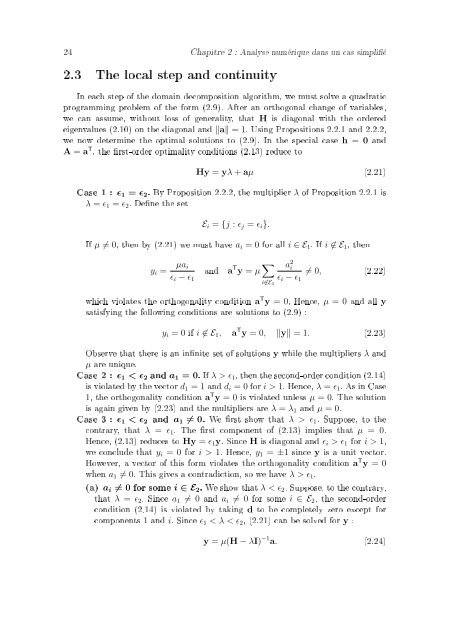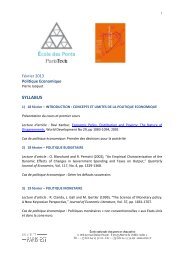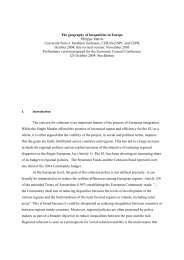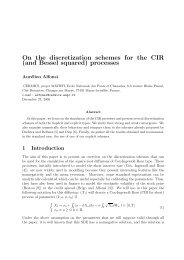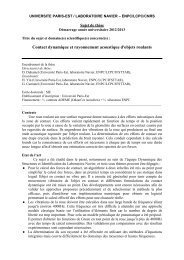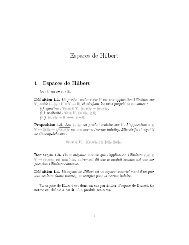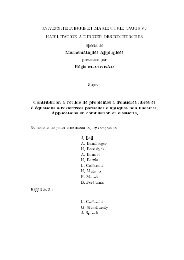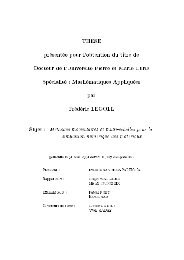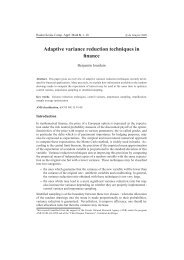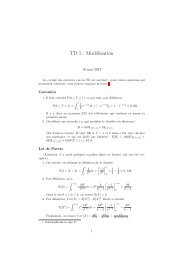You also want an ePaper? Increase the reach of your titles
YUMPU automatically turns print PDFs into web optimized ePapers that Google loves.
24 Chapitre 2 : Analyse numérique dans un cas simplié<br />
2.3 The local step and continuity<br />
In each step of the domain decomposition algorithm, we must solve a quadratic<br />
programming problem of the form (2.9). After an orthogonal change of variables,<br />
we can assume, without loss of generality, that H is diagonal with the ordered<br />
eigenvalues (2.10) on the diagonal and ‖a‖ = 1. Using Propositions 2.2.1 and 2.2.2,<br />
we now determine the optimal solutions to (2.9). In the special case h = 0 and<br />
A = a T , the rst-order optimality conditions (2.13) reduce to<br />
Hy = yλ + aµ (2.21)<br />
Case 1 : ɛ 1 = ɛ 2 . By Proposition 2.2.2, the multiplier λ of Proposition 2.2.1 is<br />
λ = ɛ 1 = ɛ 2 . Dene the set<br />
E i = {j : ɛ j = ɛ i }.<br />
If µ ≠ 0, then by (2.21) we must have a i = 0 for all i ∈ E 1 . If i ∉ E 1 , then<br />
y i =<br />
µa i<br />
ɛ i − ɛ 1<br />
and a T y = µ ∑ i∉E 1<br />
a 2 i<br />
ɛ i − ɛ 1<br />
≠ 0, (2.22)<br />
which violates the orthogonality condition a T y = 0. Hence, µ = 0 and all y<br />
satisfying the following conditions are solutions to (2.9) :<br />
y i = 0 if i ∉ E 1 , a T y = 0, ‖y‖ = 1. (2.23)<br />
Observe that there is an innite set of solutions y while the multipliers λ and<br />
µ are unique.<br />
Case 2 : ɛ 1 < ɛ 2 and a 1 = 0. If λ > ɛ 1 , then the second-order condition (2.14)<br />
is violated by the vector d 1 = 1 and d i = 0 for i > 1. Hence, λ = ɛ 1 . As in Case<br />
1, the orthogonality condition a T y = 0 is violated unless µ = 0. The solution<br />
is again given by (2.23) and the multipliers are λ = λ 1 and µ = 0.<br />
Case 3 : ɛ 1 < ɛ 2 and a 1 ≠ 0. We rst show that λ > ɛ 1 . Suppose, to the<br />
contrary, that λ = ɛ 1 . The rst component of (2.13) implies that µ = 0.<br />
Hence, (2.13) reduces to Hy = ɛ 1 y. Since H is diagonal and ɛ i > ɛ 1 for i > 1,<br />
we conclude that y i = 0 for i > 1. Hence, y 1 = ±1 since y is a unit vector.<br />
However, a vector of this form violates the orthogonality condition a T y = 0<br />
when a 1 ≠ 0. This gives a contradiction, so we have λ > ɛ 1 .<br />
(a) a i ≠ 0 for some i ∈ E 2 . We show that λ < ɛ 2 . Suppose, to the contrary,<br />
that λ = ɛ 2 . Since a 1 ≠ 0 and a i ≠ 0 for some i ∈ E 2 , the second-order<br />
condition (2.14) is violated by taking d to be completely zero except for<br />
components 1 and i. Since ɛ 1 < λ < ɛ 2 , (2.21) can be solved for y :<br />
y = µ(H − λI) −1 a. (2.24)


